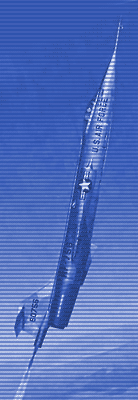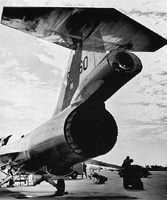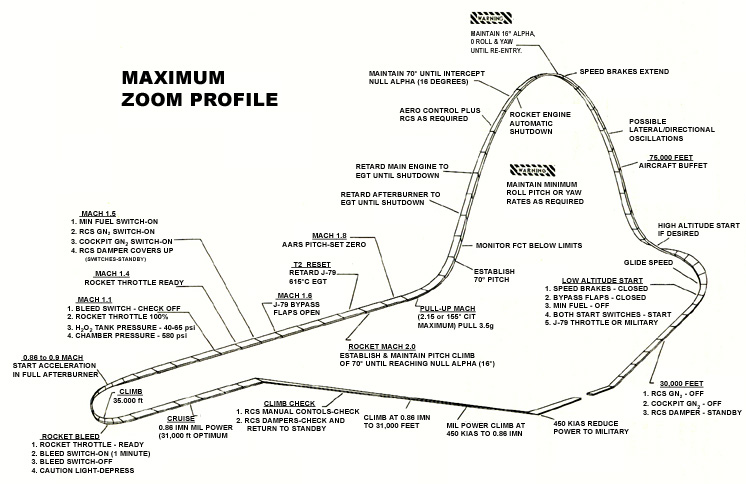The Aircraft > home
|
|
|
|
|
|
 |
The Aircraft
|
||
|
The purpose and content of this website is the description of a very unique airplane, The Lockheed Aero Space Trainer (AST), it's conception and performance and the flying experiences of the test pilots who took it to the edge of space. The AST was a major modification of the famous Starfighter, the first airplane to attain twice the speed of sound (Mach 2) in level flight. AST was designed to teach experienced test pilots to expand their capabilities into space at a time that both the Air Force and NASA were developing airplanes to journey into earth orbit and return to landing. The AST would allow a skilled test pilot to fly a rocket aircraft on the edge of our atmosphere, controlling only with rocket thrusters into a zone where it stopped operating as an airplane and became a space vehicle. It provided austere pilot training in space flight, during a very demanding and precise flight profile with an extended period of zero 'g', and with a reentry to the atmosphere similar in many ways to today's Shuttle reentry, and their "Drinkwater" approach to landing, named after the NASA engineer/pilot who developed the technique.
This aircraft was conceived under a brilliant officer and pilot , Major McElmurray, who was the Deputy Commanding Officer of the Air Force Aerospace Research Pilots School, then under the command of Col. Robert 'Buck' Buchanan. ARPS Academic Instructor Mr. Chuck Schweikhard was also instrumental in the conceptual development. This school had been set up by the Air Force as a next step beyond Test Pilot School. Its graduates were especially prepared for the NASA and Air Force Space Craft, including winged vehicles, then being designed. The first class completed training in 1961 and its small class included three future famous astronauts, all of whom later flew to the moon: Frank Borman, Jim McDivitt, and Tom Stafford. Frank and Tom remained on as instructors for Class II, made up of 7 test pilots, one of who was an Air Force finalist for the first NASA Gemini astronaut group and later was the Air Force test pilot for the AST. Even before the first class, Buchanan's staff felt an advanced flight trainer for space was vital but recognized the impossibility of acquisition through standard processes for a new aircraft. The cost, the politics and the acquisition timeline would be prohibitive. It was a credit to their technical capabilities and foresight that they recognized the potential in the NF-104A airplanes assigned to the school. Maybe more importantly, the way they approached acquiring the aircraft was equally inventive. Every school F-104A had an "N" prefix, commonly used to designate "Non-Standard" on any Air Force Airplane. In the case of the school it normally addressed only the addition of a test instrumentation package for student training. Their idea was a big stretch as just another "N" model, but it solved the approval problems. It just happens that the modification were more than very substantial, beginning with the addition of a liquid rocket motor, AR2-3, which had powered the Bell X1-A on the first supersonic flight by Chuck Yeager. Next, the addition of a dozen monopropellant rockets to control flight outside the sensible atmosphere. In this case they chose small rockets being used to control the X-15 in the manner a space capsule is controlled. The "modifications" go on and on. A fully pressurized cockpit would be necessary since full-pressure suits, when inflated, were not compatible with normal pilot functions. An oxygen-pressurized cockpit would be explosive at high altitude, as later occurred on the Apollo launch fire, so pressurized nitrogen gas would be necessary but with drawbacks, one of which almost cost the life of one test pilot. Significant changes in flight instruments would be necessary for a pilot to control in near-space, and here again they conceived unique modifications of existing equipment. For example, the Navy's standard All-Attitude Control Display was adopted by changing the Instrument Landing System meters to aeronautic measures of angle of attack (alpha) and side-slip (beta), absolutely necessary to control the airplane when it became the spaceplane. The addition of a long nose probe with large alpha and beta vanes made this possible.
The school management and a small Lockheed team worked out the detailed concept and were able to convince Air Systems Command that a shoestring modification could be funded to design and convert three existing F-104s. The project was approved, and managed under the school, with testing to be accomplished by the Air Force Flight Test Center, Test Division, before the planned turn over of the 3 AST airplanes to the ARPS. The design and major modification of the standard airplanes into the AST configuration were accomplished by a small team of Lockheed Aircraft employees in the company's Burbank plant in California. Every pilot that ever went through the ARPS flew an NF-104A, but few had a chance to fly the Aero Space Trainer, because of its brief life. The first of three ASTs, 60756, made its maiden flight on July 9, 1963, flown by Lockheed test pilot Jack Woodman.
The last two zooms of the Joint Contractor/Air Force testing were flown by Smith and Woodman on maximum zoom profiles, to 118,860 and 118,400 feet respectively. Thereafter, all zooms under the Air Force testing were flown by Smith, plus one by Rushworth, to 112,000 were maximum also.
The testing was declared complete and Yeager
made four attempted zooms, also intended to be
flown with maximum zoom profile, also achieving
a best somewhat over 103,000 feet. The
maximum zoom is represented by the chart pictured
below. Maximum Zoom Profile This overview explains the maximum zoom mission from take-off to landing, including the primary procedures and operations, from the pilot’s point of view. The detailed procedures for a pilot are available in the Partial Flight Manual (PFM), Section II, except with significant restrictions later imposed by the Yeager Accident Board. Two of many vital pre-flight checks, peculiar to AST were to set 16 degrees on the “alpha null selector”, which would be the pitch attitude guide, and the final and important pre-flight check was “ AARS erect and heading slaved” which was very important to assure that the most vital instrument during zoom was slaved to actual headings and that the critical horizontal reference was functional. The take-off roll of AST was a bit longer and all events occurred at a bit higher speed than the standard fighter because AST was heavier, even though lift was gained from the added total of four feet in wingspan, due to the additional wing tip segments housing roll thrusters. The afterburner was always used for zoom takeoffs, with nominal indicated airspeeds in knots of 185 at nose wheel lift-off and take-off at 210 CIAS. Wing flaps were raised at 260 and level acceleration to 400 knots was the point of terminating afterburner and start of climb in full military power. Acceleration was continued to 450 in the early climb to retain that climb speed until an indicated Mach number, after which climb rate was established to maintain 0.86 Mach to mission altitude. We climbed west out over the Pacific then turned around for our run-in at 35,000 on an easterly heading, calculated to reach the pull-up in a position north of the base, in event of inability to restart, necessitating a dead-stick landing. During this period the RCS was checked, and preparations for ignition of the rocket motor were completed. The run-in to pitch up started with military power going to full afterburner at the appropriate point to achieve precise pull-up location. The necessary checks are presented in the chart above. At Mach 1.8, the final pitch alignment of the AARS was set. For maximum performance, it was beneficial to get as much of the acceleration from the unassisted jet engine which could go all the way to Mach 2.2 depending on environmental conditions at altitude, saving the rocket time for vertical flight! It was also ideal to be at only 1200 pounds of jet fuel at pull-up, for a lighter AST, thus higher altitude. The rocket engine was ignited at full thrust while still in level flight and the 3.5 g pull-up was initiated at the 2.2 Mach point. (The exception was my highest zoom with a pull-up at Mach 2.4.) All of these preliminaries to the climb, especially the exactness of the pull-up, were crucial to best performance. In order to provide safe conditions upon reentering after zoom, re-trim from the level position, before pull-up was not permitted. That did add difficulty to retaining constant pitch angle thus to the frequency of monitoring the AARS, but that gage would be the most vital throughout the zoom in any event. Upon achieving a precise 70 degree pitch angle before giving up any of the 3.5 g’s, maintaining that precise angle became the most imperative task for maximum altitude, thereafter. Pitch angle, being the airplane’s longitudinal reference to the horizon was very near its flight path angle at the end of the pull up, with the very high Mach, thus low angle of attack. However to maintain that 70 degree climb path as the speed began to dissipate, required a gradual increase in angle of attack to supply lift, so the pilot was sitting at 84 degrees and more, his back virtually horizontal, because the ejection seat was installed to cant back 14 degrees to the airplane. The pressure suits fixed helmet and visor provided a limited field of view straight ahead. Consequently, from pull until descending all flight control was on instruments, since reference-free sky was the only sight, and the flying job allowed virtually no time to view it. The climb to apogee was a true straight path 70 degree climb until airspeed got too low. During that straight but challenging effort to maintain a perfect climb, there were distractions and vital chores. The distractions were the necessary checks of vital instruments and system functions. The chores which resulted included throttling the afterburner to stay within limit as jet exhaust gas temperature was monitored, until it had to be shut off to avoid damage at around 75,000 feet. In the range of 85,000 that procedure was followed from full military all the way to idle power, which was maintained until EGT was exceeded, then engine was shut off. Then a curved flight path was formed from the tangent between the fixed 70 degree pitch and the increasing alpha (relative wind) until alpha reached 16 degrees. At that point, aerodynamics was virtually out of the situation and a ballistic AST had arrived on its parabolic path. Gravity would control that path, but the pilot had the toughest job, just ahead, which was to maintain proper attitude on a path he could not alter. The pilot could not change the path again until the AST had reached its apogee and fallen back, well into aerodynamics region. But he had his most vital and difficult job just to assure that the AST would be properly aligned with that path in all three axes throughout that space journey. It was especially challenging in the pitch axis, where rapid control changes were necessary, with a unique space control and stability, to assure the reentry would occur at 16 degrees with near zero yaw and roll. Maintaining alpha was always the most important and demanding task, especially in the space adventure but even in the resulting dive to earth. A risk reduction during reentry was made possible, after our early testing, by a modification to speed brakes which made their use possible during recovery from zooms, removing a coffin corner from the profile. Final descent, short the occasional dead-stick landing if relight failed, was routine and was the time in which you realized just how hot that suit became
Limited use of the remaining two ASTs
was the only flying ever permitted after Major
Smith completed all the tests required by the
Yeager Accident Board and the remaining two ASTs
were finally returned to the ARP School for student training, as directed, with the restricted profile to assure that the aircraft were always within the aerodynamic control region.
It should be noted that all of the data in the
partial Flight Manual reflect only the
restricted flight regime, not the maximum
performance. This greatly reduced the likelihood of entering uncontrolled flight during a zoom by lowering the maximum altitude, decreasing the climb angle, increasing the minimum airspeed, and decreasing the angle of attack limit to 12 degrees. These safety features assured remaining outside the zone in which true space control could be experienced, but in so doing offered little, if any, spacecraft training and experience not offered by the ordinary F-104A zooms. It became an expensive "Gee Whiz" ride and possibly a confidence builder. Another AST flight accident occurred later from an explosion in a rocket oxidizer tank that resulted in safe recovery of the instructor pilot in one of the school staff's checkouts. A similar ground incident resulted in un-repairable damage to the aircraft, ending the life of the Aerospace Trainer Program, with one becoming a static display on a pedestal at Edwards, AFB. Even that last airplane suffered ravages when its special nose section was allowed to be borrowed by Mr. Daryl Gruenmeyer to further modify a civilian F-104 in which he had set a
low altitude speed record, and the aircraft was
destroyed in a crash.
|


